8 Steps To Start Your Online Business & Build A Brand
Feb 26, 2019
Welcome to Part 1 in a Trilogy of Articles on How to Create a Brand That Lets You P.L.A.Y.
P.L.A.Y. lets you:
- Create Passive Income so you can make money with minimal effort.
- Enjoy the Lifestyle your Brand’s profits provide.
- Build your Authority so you can leave your mark in the world.
- Do what You’re really passionate about so you feel fulfilled every day.
If you’re wanting to create a Brand around yourself, a creative Vision you have or your expertise, you’re going to love what you’re about to discover…
Before we venture forth, let me introduce myself…
My name is Mike L. Murphy and I’m the co-creator of the Visionary Planner. I started out probably a lot like you...I wanted to 'quit' my day job so I could build a business that gave me passive income. Of course, that sounds a lot easier than it really is (we created The Visionary Planner to connect all the dots of what a successful business needs so you can stop feeling lost and confused).
Before we continue, let’s define a few things. You’ll need to know these terms so the rest of what you’re about to read makes sense!
Brand:
A set of expectations, memories, stories and relationships that, taken together, account for an Audience’s decision to choose one product or service over another.
A great Brand should deliver a clear message, provide credibility, create an emotional bond, motivate an Audience to buy, and create Guest loyalty.
Audience:
The assembled spectators, listeners or readers who are interested in the topic of a Brand.
Guest:
An Audience Member who purchases any of a Brand’s Treasures. In the Visionary Planner we call customers Guests in order to emphasize the fact that a Visionary should treat all Treasure Buyers as honored Guests.
Treasure:
A valuable product or service that the Audience of a Brand purchases.
What makes a Brand great?
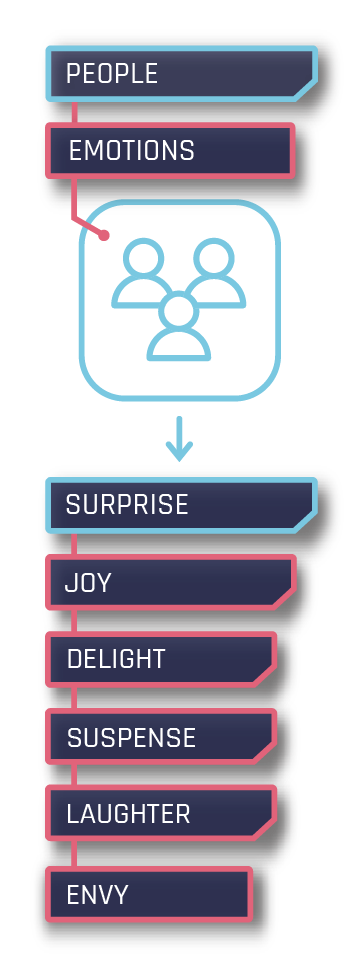 A great Brand creates a great Audience Experience. An Audience Experience is the series of emotions an Audience feels as they interact and engage with your Brand.
A great Brand creates a great Audience Experience. An Audience Experience is the series of emotions an Audience feels as they interact and engage with your Brand.
Who is the Audience made up of? People! What are people? They’re human beings! What do humans feel? Emotions!
Let me say this a different way…
If a human is a car, the fuel they need to be engaged in your Brand is ‘emotions’. If your Brand fails to ignite their emotions they’ll cruise on down the highway until they find a Brand that does. The best way to fire off people’s emotions is to use the art of Storytelling.
Nike tells the story that if you strap on their shoes you can ‘just do it’. Apple uses Storytelling to make you feel so smart by using their products to stand apart from the herd by ‘thinking different’’. And Disney uses Stories to make you fall in love with their characters so you buy your kids every toy under the sun.
If you can accept my hypothesis that an Audience want to experience Stories that excite their emotions, then we can start to analyze a great example of a Brand that does this.
Before we examine this Brand, let’s go back and look at some of the most successful Visionaries…
No one would argue that DaVinci, Michelangelo, Einstein, Edison and Jules Verne are all Visionaries. In our modern era we have Charlie Chaplin, Walt Disney, Oprah Winfrey, Steve Jobs, J.K. Rowling and Elon Musk. Of all those geniuses, the one that made the most profound impact on me was Disney.
If we look at the man’s life, he kept topping each of his Visions with an even greater one.
The pinnacle of his success is Disneyland*.
The man was an entertainer. He knew how to use Stories to ignite the emotions of his Audience. He mastered how to do this on a movie screen and in 1955 rose to the challenge of doing this in a four-dimensional environment.
If you’ve never been to Disneyland, it’s an amazing Audience Experience (large crowds of pushy tourists aside). Walt wanted to pamper his park’s Visitors (which he called ‘Guests’), so he planned everything down to the finest detail.
If we’re going to study how to create an amazing Audience Experience then I say we look no further than Disneyland. (Disneyland is trademarked by Disney and has no affiliation with the Visionary Planner Brand! I’m just using Disneyland as a teaching example because I’m incredibly nerdy.)
Let’s examine how Disneyland’s experience relates to creating an amazing Audience Experience for your Audience and Guests!
Due to copyright laws (and Disney’s vast army of lawyers), I’ve taken the liberty of commissioning a very talented artist to create a theme park of our own. Let’s call this the ‘Visionary Park Map’.
You’ll see there are four themed lands…each one outlines a higher achievement in Entrepreneurial-ness. It starts with a caveman inventing the wheel, to the amazing inventions in the Renaissance, to the Industrial Revolution, on to modern day high technology. Looking back now I see we forgot the homage to the six year’s lemonade stand, but I digress!
Visionary Park Map
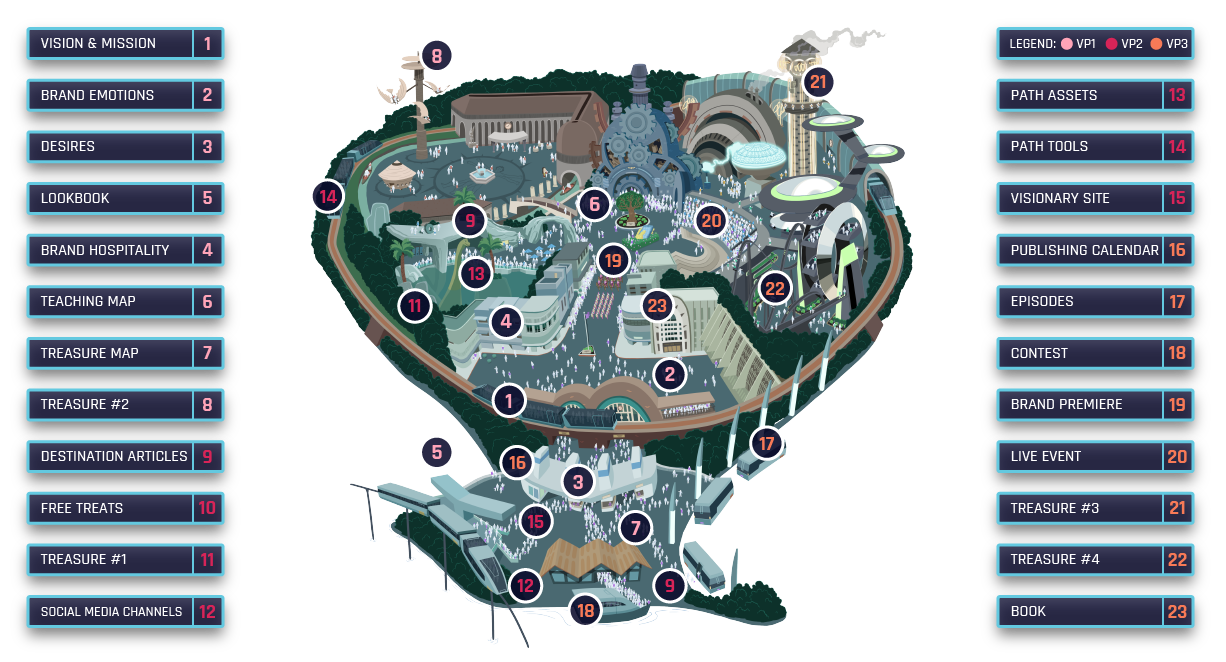
Looking at the map above, you'll also note that the four phases of the Visionary Loop are planned out. Check out this short video to discover just what the Visionary Loop is:
The 23 Blocks on the map correlate with our Visionary Planner Training (which we broke into 3 parts so our students don’t get completely overwhelmed). There are 23 Blocks to creating an online Brand, and these are all organized under the corresponding phase of the Visionary Loop.
For the remainder of this article, let’s examine what Blocks happen in the first two phases of the Visionary Loop…
Visualize and Research & Study.
Our students work on these in Planner #1 of our deluxe training. We also have a free version of this training that you can access at the end of this article.
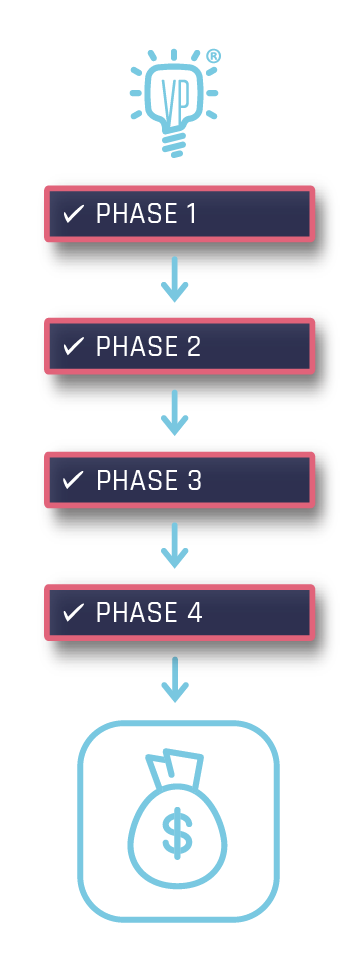 The ‘Visualize’ phase of the Visionary Loop is where you get that ‘bright idea’ of what your Vision is. This is where you define it so you have a clear plan on what you’re about to construct. This is where you dream up your Brand from a ‘big picture’ conceptual level.
The ‘Visualize’ phase of the Visionary Loop is where you get that ‘bright idea’ of what your Vision is. This is where you define it so you have a clear plan on what you’re about to construct. This is where you dream up your Brand from a ‘big picture’ conceptual level.
The second phase of the ‘Loop’ is where you Research the skills you need (that you don’t yet have) so you can be an Authority in your field. For Disneyland, this is where Walt and his team of Imagineers spent years planning where they’d build the park, how much it’d cost, who might buy tickets to attend and what possible problems might arise.
This second phase also consists of Studying exactly how to build your Vision.
In the case of Disneyland, this is where Walt hired teams of artists and engineers to figure out how to do things that had never been done before. After all, you have to study architecture and design so you know how to build a castle in the middle of a Southern Californian orchard.
If you’re going to Premiere a Brand about ‘how to train your dog’ then this is where you’d study dog psychology (chasing balls makes them happy), dog anatomy (they have a tail that wags) and dog behaviors (they like to drink out of the toilet when you’re not looking). If you didn’t know these things then you would have a hard time being an expert at dog training!
Chances are there is a lot of knowledge you need to master before you can truly be the type of Authority who can make a dramatic impact in the lives of your Guests. (A Guest is anyone in your Audience that buys your stuff.)
A lot of (failed) Visionaries like to jump from Phase 1, ‘Visualizing’ right to Phase 3, ‘Producing’ their Vision. They skip the crucial ‘Research & Study’ phase which leads to them getting overwhelmed, running out of time and money. This then causes them to give up.
If you're onboard, let’s break down what each step is in building an online Brand and how those Blocks relate to a theme park. Keep in mind that Disneyland is a tangible, real place you can visit.
Unfortunately an online Brand is more vague…
Because it’s not real, it can be hard to grasp certain concepts. Therefore, relating it back to a real experience like Disneyland will hopefully clarify exactly what a kick-ass Audience Experience is really like!
I wish someone had explained this to me before I started building my first Brand! This info would have helped me perform each step in the correct order which would have contributed to me making my first Brand a success, instead of a painful (but necessary) learning experience.
Ready to discover what the first 8 Blocks are? We call these Blocks because, just like Lego Bricks, you use them to build your Brand.
1. Vision and Mission Statements
A Vision Statement describes the future and outlines WHERE you want to it be. It also communicates the purpose and values of your Brand.
A Mission Statement talks about the present leading into the future. It outlines ideas on HOW to accomplish the Vision Statement.
 A well planned Vision and Mission inspires you to commit to your ideas. Committing to those ideas then keeps you on track to make sure they happen. A shoddy Vision and Mission is like having a list of flashy words that mean nothing and impress only Aunt Matilda during your rather boring family get-togethers.
A well planned Vision and Mission inspires you to commit to your ideas. Committing to those ideas then keeps you on track to make sure they happen. A shoddy Vision and Mission is like having a list of flashy words that mean nothing and impress only Aunt Matilda during your rather boring family get-togethers.
Does Disneyland have a Vision and Mission? Did Walt Disney, one of the most influential Visionaries (and business tycoons) think it was important to have these two things? The answer to both of these questions is YES!
When you enter Disneyland you’ll notice two plaques that rest above the tunnels, under the train tracks. Every Guest to Disneyland passes under these.
These plaques clearly state what Guests can expect…
“Here you leave the world of today and enter the world of yesterday, tomorrow and fantasy.”
Then a few meters later Guests can find a second plaque that states the promise and values of Disneyland.
“To all who come to this happy place: Welcome. Disneyland is your land. Here age relives fond memories of the past - and here youth may savor the challenge and promise of the future. Disneyland is dedicated to the ideals, the dreams and the hard facts that have created America - with the hope that it will be a source of joy and inspiration to all the world.”
 There is a profound reason why Walt felt it necessary to include these two plaques. Ironically, all of the other Disney parks (the ones that aren’t clones of Disneyland) do not feature plaques like these. These parks lack the cohesive Vision of a singular leader like Walt (as they were created by committees of people instead of a single man with a Vision).
There is a profound reason why Walt felt it necessary to include these two plaques. Ironically, all of the other Disney parks (the ones that aren’t clones of Disneyland) do not feature plaques like these. These parks lack the cohesive Vision of a singular leader like Walt (as they were created by committees of people instead of a single man with a Vision).
Your Brand should, just like Walt's original park, have a Vision and Mission Statement.
You need a Vision Statement to define the Vision you have for your business. WHERE do you envision your Brand to be in the future? What greater purpose are you setting out to create for your Audience? The best Visions are aspirational, concise and clear.
Next up, you need an amazing Mission Statement. What’s the difference between the Vision and Mission? The Vision states where you’re going. The Mission states how you'll get there.
For example, your Vision might be ‘A world where Visionaries are free to create, and use their Visions to educate and entertain generations’. While that sounds cool, making that Vision happen is shaky at best. That’s why the Mission Statement for that might be ‘by providing step-by-step instructions, easy to follow course materials and providing coaching so no Visionary has to feel overwhelmed ever again.’
Do you see how the Vision speaks to the ‘target that needs to be hit’, while the Mission breaks down the broad action steps to hitting that target?
When you can clearly define these two ‘statements’ you can then stay on target, and direct your Team to stay on target as well.
It also allows your Audience to know what they can expect of your Brand. Communication is the key to all great relationships, and having a solid relationship with your Team and Audience is the only way your Brand will deliver an amazing Audience Experience. Just like a theme park!
2) Brand Emotions
The three core Emotions that define what a Brand wants its Audience's emotional state to be in order to bond with them.
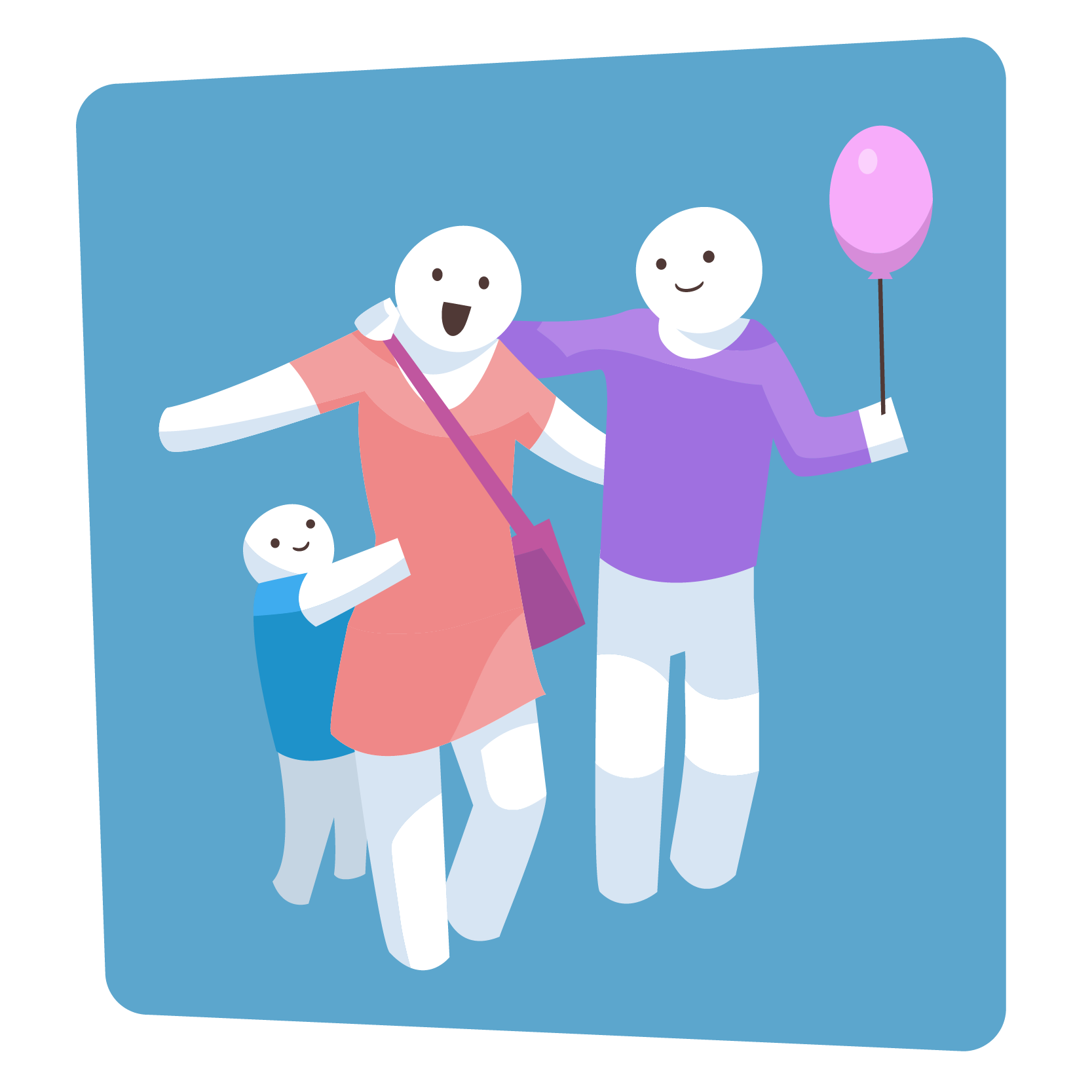 Walt intimately knew what his Guests wanted. Why? Because he was his ideal Guest!
Walt intimately knew what his Guests wanted. Why? Because he was his ideal Guest!
Walt only created Disneyland out of the need to create a safe amusement park he could take his two daughters to. Back in the 1950’s there weren’t a lot of options. This problem upset Walt enough that he got a Vision to build Disneyland. He wanted a place for parents to experience the magic of childhood with their kids.
He wanted his guests to feel Safe, Magical and Nostalgic. Every aspect of Disneyland makes its Guests feel these three Emotions.
Imagine if the three core Emotions Walt wanted Guests to feel was ashamed, bored and humiliated. Disneyland would be a very different experience.
You need to define the three core Emotions you want your Guests to experience and then engineer those Emotions into the DNA of your Brand. Not doing this will result in you creating a generic Brand that makes Guests feel nothing in particular.
3) Lookbook
A set of guidelines and graphical examples of how a Brand looks and what it represents. A Lookbook is used by a Visionary and their Team to create a consistent experience for their Audience and Guests.
Disneyland has different themed lands. Each land is meant to create a unique Emotional experience for Guests.
- Adventureland is meant to evoke the feelings of discovery and danger.
- Fantasyland is meant to dazzle Guests with magic and whimsy.
- Tomorrowland is meant to infuse Guests with the promise of future technologies.
Each of these lands generate these Emotions in their Audience by using Visual Branding.
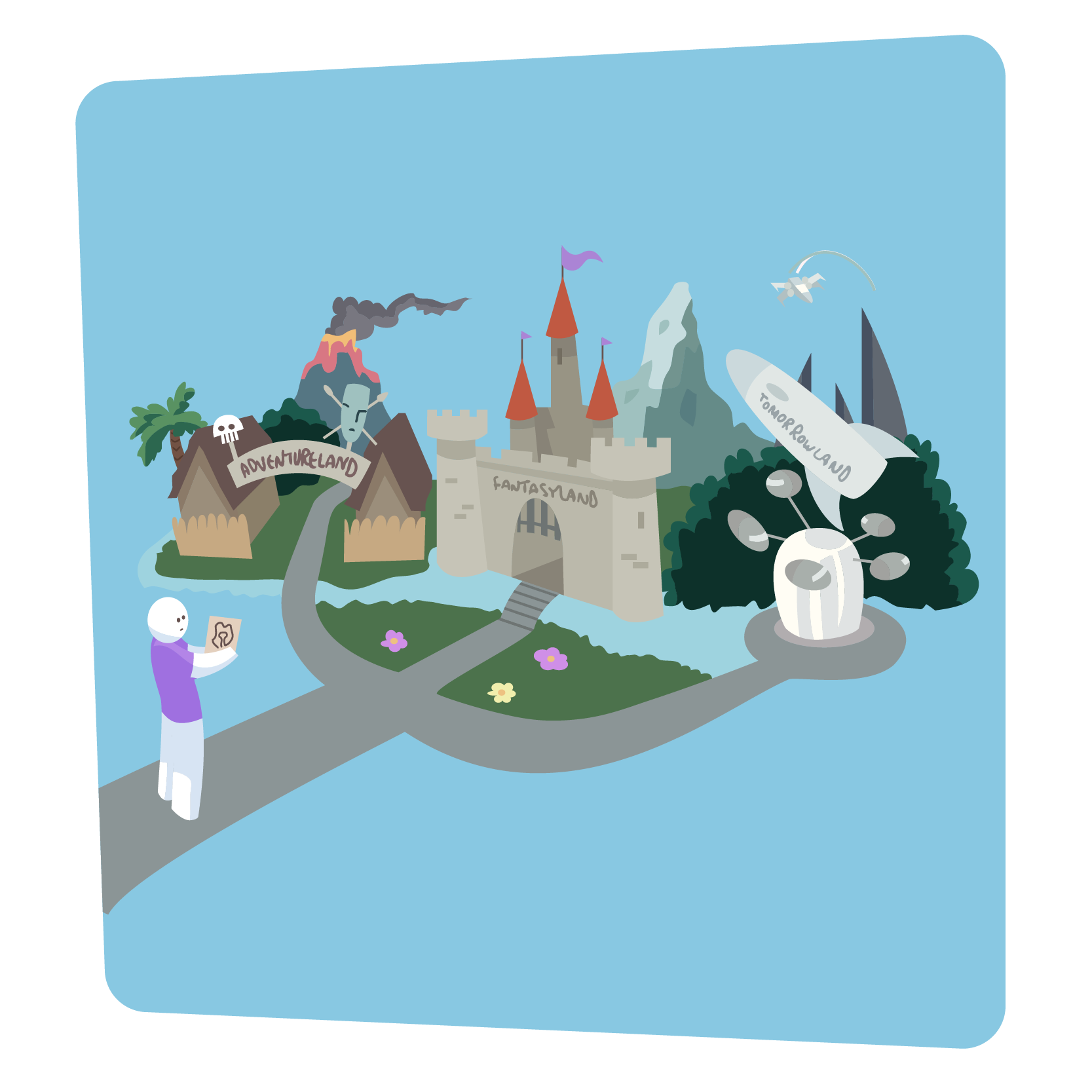 What is Visual Branding?
What is Visual Branding?
It’s when colors, fonts and shapes all work together to create a specific Audience Experience. Fantasyland features fanciful cursive fonts, in purples and golds and round, non-threatening shapes. Adventureland features fonts that feel like old travel advertisements from the 1930’s, with jungle greens and browns and sharp dangerous shapes.
In short, each themed land has its own Visual Branding.
How do the Disney Imagineers (the artists and engineers who build the parks) keep the Visual Branding consistent in each land?
They use a thing called a Lookbook. Simply put, a Lookbook is a document that lists out all the fonts, colors, shapes and design motifs associated with a Brand (or in this case, with a themed land).
So what is the equivalent for your Brand?
Just like Disney, you need to have a Lookbook created. Unless you’re a Designer, you should hire one to create this Branding for you.
Your Lookbook should include your Brand’s colors, fonts, patterns, shapes and examples of Social Media images and product images.
If you’ve ever seen a Brand that looked ‘junky’ or ‘cluttered’ chances are the Brand owner put zero thought into creating consistent (and eye-pleasing) Visual Branding!
4) Brand Hospitality
The friendly and generous reception and support of an Audience. This includes systems and Team Members who help solve any problems and answer questions that an Audience and Guests may experience while engaging with a Brand.
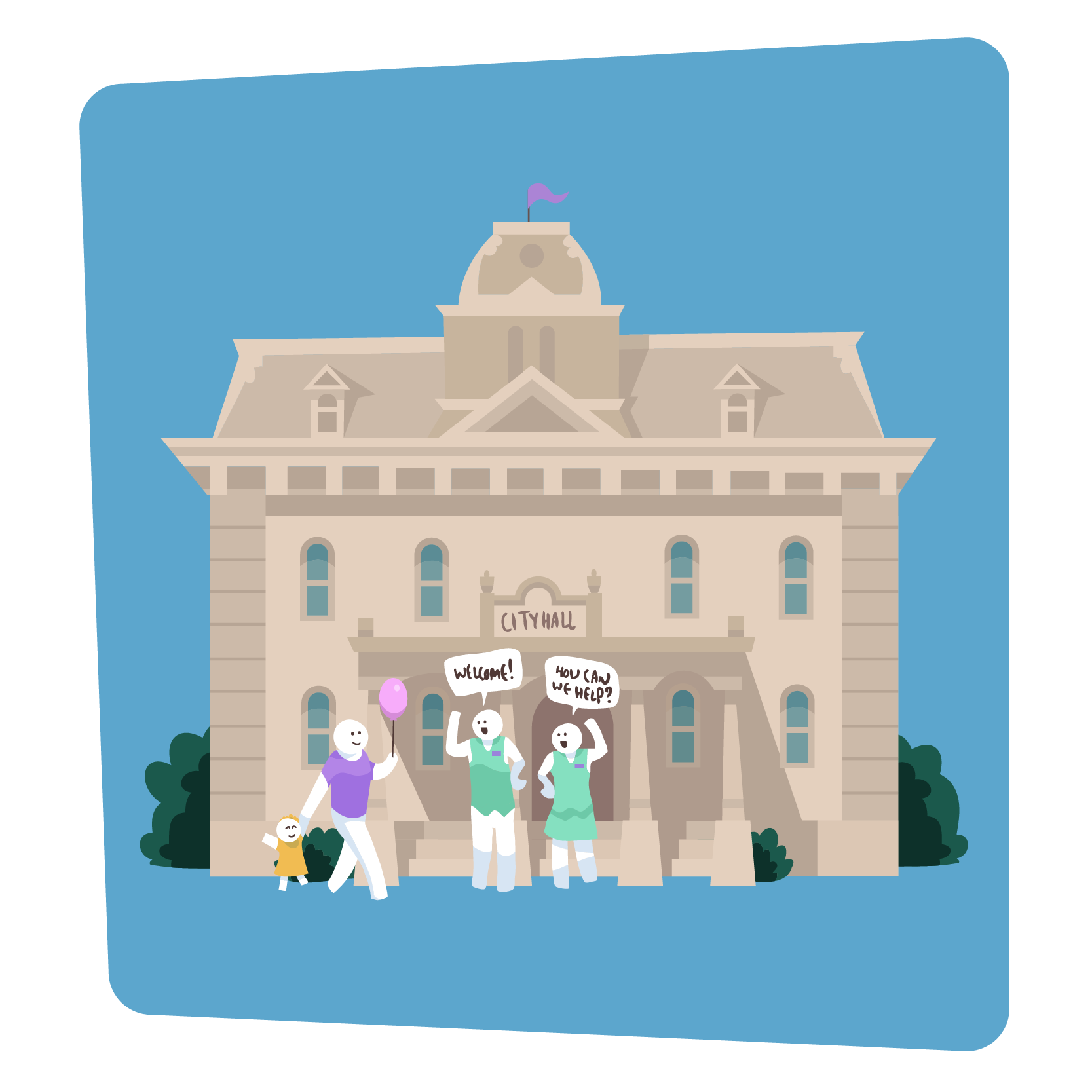 What makes Disneyland so great?
What makes Disneyland so great?
The amazing customer service (which we call ‘Brand Hospitality’)! They really treat Guests like Guests!
Disney is so great at customer service that there have been numerous books written on the subject, and Disney even has ‘Disney University’ that consults other Brands on how to make their customer service ‘magical’.
Great customer service simply means respecting the customer or Guest. Making them feel like a V.I.P. and surprising them with unexpected and thoughtful touches that go beyond what they were anticipating.
For your Brand, you must define what Customer Experience you want your Audience and Guests to receive.
How will your Brand manage refunds, questions and requests? What special surprises can you do for your Guests? Who will interact with all of your Guests? What is your policy for handling upset Guests? Will you let Guests interact with you via a Social Media Channel, a chat box, a phone or help desk?
There are several questions you need to answer in order to make sure your Brand Hospitality is as well thought out, and solid as it can be.
5) Desires
The end result of an Audience’s strong feelings of wanting to achieve something or have a positive experience that a Brand can fulfill for them.
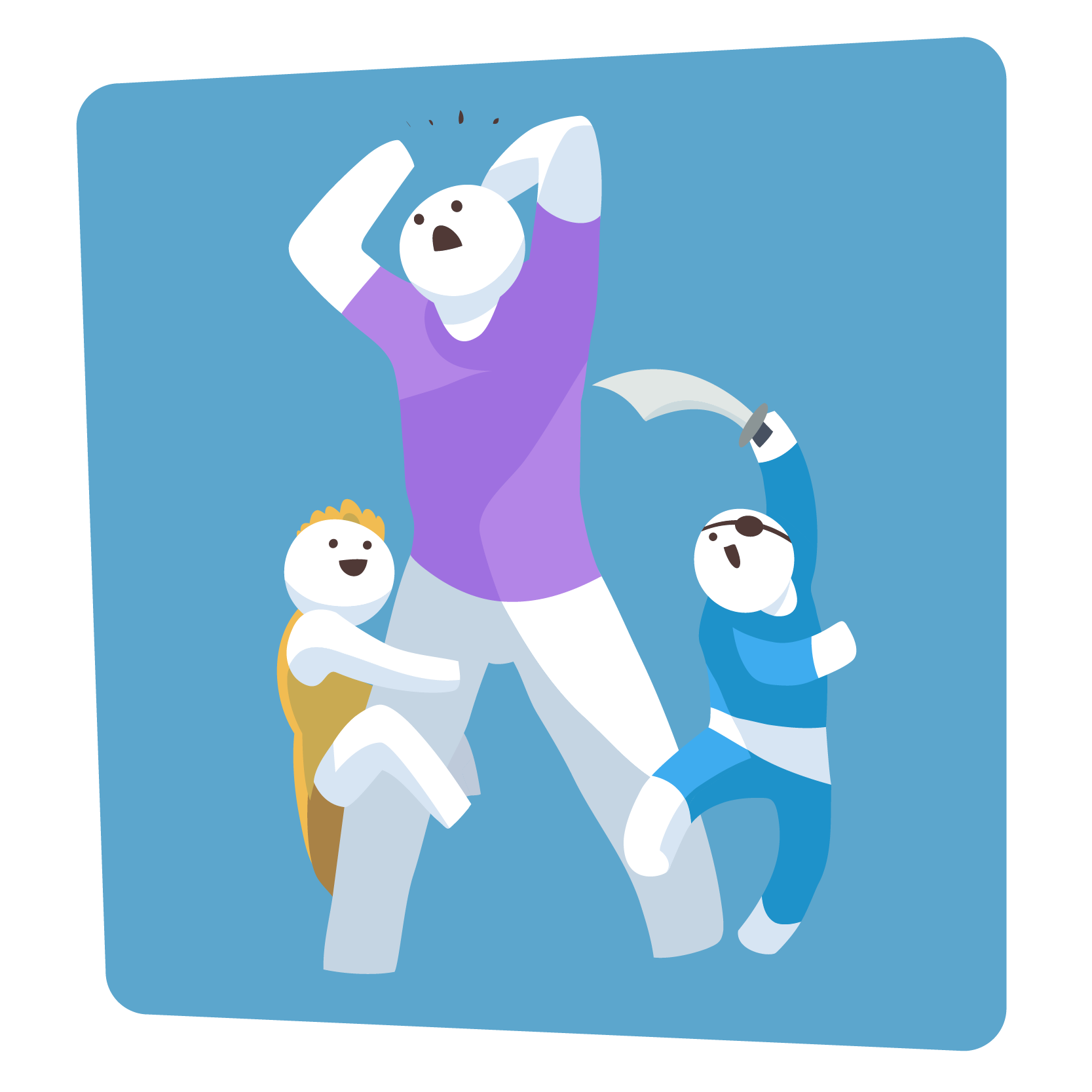 Every single Guest at Disneyland ‘Desires’ something. Little girls Desire to be a Princess for a day. Little boys Desire going on a swashbuckling adventure. Moms Desire getting that postcard perfect pic of the kids enjoying life. Dad Desires not going bankrupt as he pays $27.50 for a kids size hamburger.
Every single Guest at Disneyland ‘Desires’ something. Little girls Desire to be a Princess for a day. Little boys Desire going on a swashbuckling adventure. Moms Desire getting that postcard perfect pic of the kids enjoying life. Dad Desires not going bankrupt as he pays $27.50 for a kids size hamburger.
Each Guest has their own special ‘Desire’ or wish they want fulfilled.
Keep in mind Disneyland gets tens of thousands of visitors each day. On an average day the park attendance hits around 50,000 people! Each person is unique and has a specific Desire that must be fulfilled in order for them to feel ‘satisfied’. If little Sarah wants to meet Princess Elsa and get a photo, then she’s going to go to bed a little cranky if that expectation isn’t met.
Your Brand needs to know the Desire of each and every person in its Audience. When you know their Desires, and grant their wishes, they’ll be much more prone to paying you money (so they can become Guests of your Brand).
But there's a big problem…
How do you manage all these Desires? In the case of Disneyland, giving 50,000 Guests personal attention would be an impossible task!
How do they do it?

They group their Guests into Desires, or buckets. They sort those 50,000 daily Guests into ‘Parental Figure’, ‘Son’, ‘Daughter’, 'Teens’ and ‘Nerds’. Making these groupings let’s them create broad experiences that please 80% of their guests. Sure, there are about 20% of people who might not fall into one of these groupings, but trying to please everyone will result in pleasing none!
Every successful Brand must know what their Audience and Guest’s Desire. Let me give you another example…
Let’s say it’s lunchtime and you’re sitting down at some Disneyland restaurant. You look at the menu… What do you see? Are the food listings randomly arranged all over the page? No! The menu items are arranged into groups. Soups and Salads are in one section. Drinks are in another. Dessert in another. Main courses in another, and on and on… Why are all menus arranged this way? So that people can easily locate what they Desire to eat and order it!
In your Brand you must think about, and then group together the Desires of your Audience.
It’s impossible to give each person (at least online) one-on-one attention. But by grouping them you can use E&E Marketing (and Audience Path) that focus on fulfilling a core Desire.
What is E&E Marketing?
That’s when you use Entertainment and Education, instead of Pushing and Persistent tactics (P&P Marketing), to share your Brand’s Story.
Instead of saying ‘buy my stuff, sale ends in 20 minutes, only one left, don’t be a loser', etc… you’d simply Educate the Audience (while using Entertaining Stories) so they can understand the value, and how the product/service will improve their lives. One type of Marketing is welcoming, whereas the other type is repulsive.
The Visionary Planner trainings teach that you should pick 3 Desires for your Audience. Less than 3 and you might be too broad. More than 3 and you’ll become overwhelmed juggling too many options. For some reason 3 seems to be a magic number. Most problems your Brand helps solve can be boiled down to 3 groupings which allow you to create 3 very clear Marketing Channels.
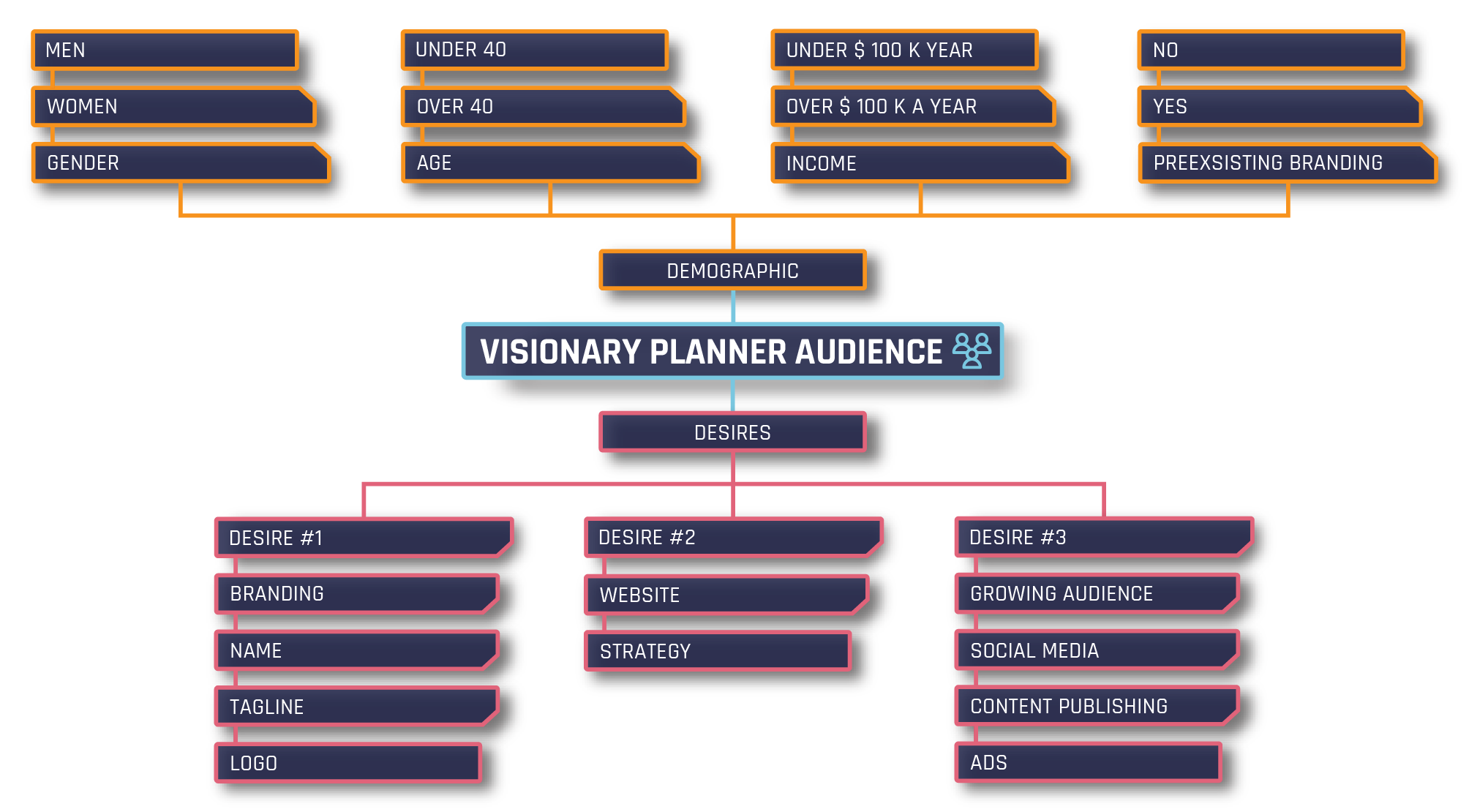
Once you define what the 3 main Desires of your Audience are you can tell Stories of how you help grant those wishes (and make for some very pleased Guests!)
For example, the Visionary Planner’s Audience falls into these 3 Desires:
- People who are just starting out and need Branding advice.
- People who want to improve their site and create products.
- People who want to know how to grow their Audience (by using ads and social media).
We figured these 3 Desires out by interviewing our Audience (just like you’d talk to Guests at a party) and examining keyword research (which reveals what solutions to problems our Audience is searching for online).
All 3 of your Brand’s Desires have the same ‘big’ end goal!
Just like all Guests at Disneyland want to ‘have fun’, all Guests of a ‘dog training Brand’ want a well-trained dog.
We can break the dog owner’s Desires into the following 3 groups:
- People who need help training a puppy (potty training, crate training, not whining).
- People who want to train a dog to perform certain behaviors (walking on a leash, sitting, coming when called).
- People who have a dog with serious behavioral problems (like biting, whining or anxiety) that need to be immediately fixed before something horrific happens.
All 3 Desires are sub-sets of ‘wanting a well-trained dog’. Can you see how each of those 3 Desires requires a different type of communication? For example, you wouldn’t talk to the people who are having serious dog issues (like a dog biting them) the same way as you’d talk to someone who is excited at the prospect of training their adorable puppy.
6) Teaching Maps
Teaching Maps are tools that use different memory techniques in order to present ideas in a simple & unique manner. Teaching Maps help you to remember and understand the content, which are the two foundational steps when learning anything new.
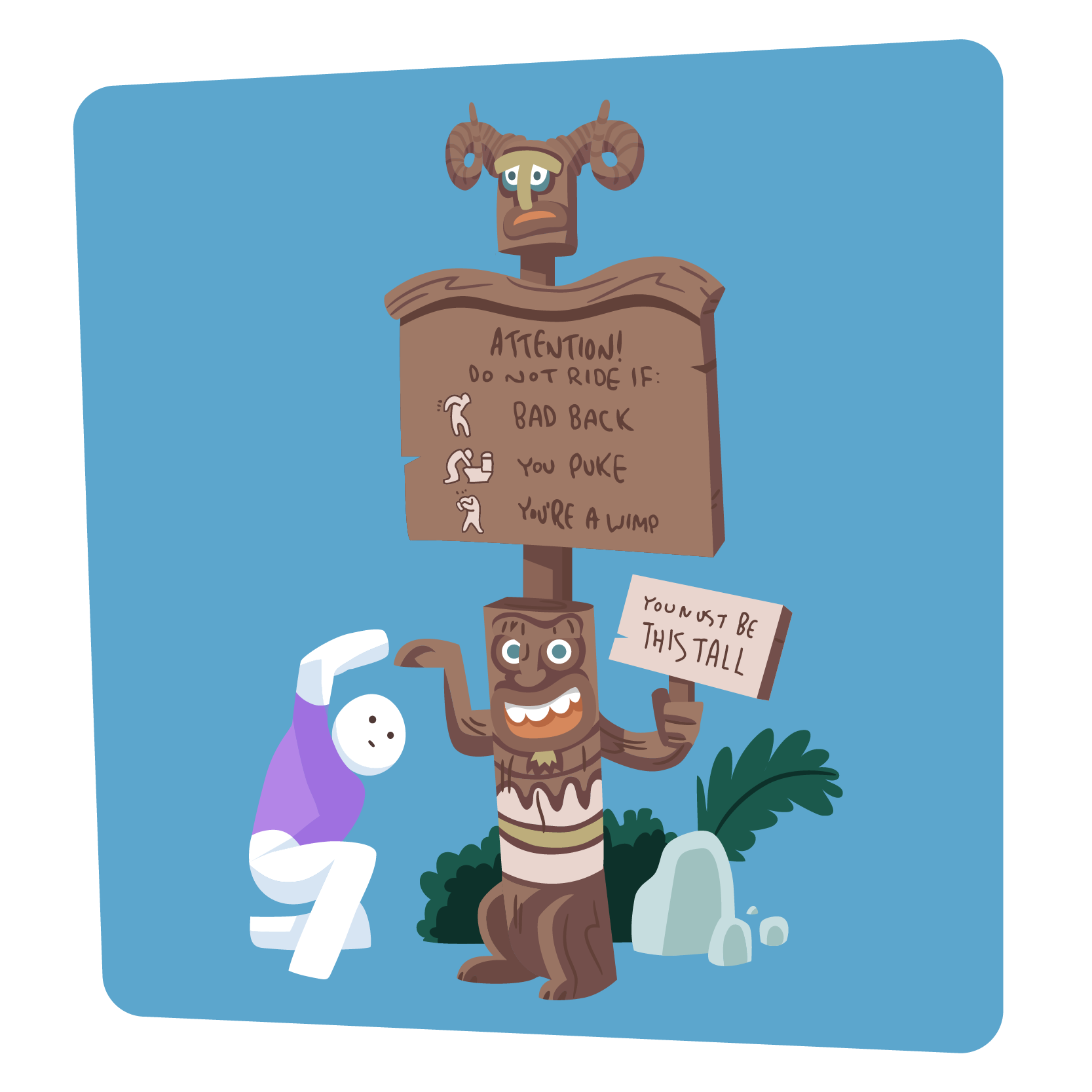 This is really important because there is no way someone can take action on something if they don’t understand the basic concepts. For example, we can tell you that it’s really important for your Brand to have different types of Treasures. But you won’t do anything with this valuable information unless you understand that a Treasure is a product or service. You’d need to remember that there are 4 types of Treasures that range in different prices within your Brand. Once you know this you’d be more prone to learn more and take action.
This is really important because there is no way someone can take action on something if they don’t understand the basic concepts. For example, we can tell you that it’s really important for your Brand to have different types of Treasures. But you won’t do anything with this valuable information unless you understand that a Treasure is a product or service. You’d need to remember that there are 4 types of Treasures that range in different prices within your Brand. Once you know this you’d be more prone to learn more and take action.
How does Disneyland use Teaching Maps?
Every ride at Disneyland has a set of instructions that ‘Teach’ each Guest how to safely experience the ride and what the Story is. Some rides warn about height restrictions, and some rides need to set up the Story so the ride makes sense.
Your Brand should present its foundational ideas to your Audience in a way that they can easily grasp and remember. Most likely the solutions you help your Audience solve are extremely complex. That means you must find an simplified way to present your solutions so that a person who knows nothing about what you’re Teaching can easily ‘get it’. Once you can do this it makes Educating that person so much easier. They can ‘see’ how you can help them and they become much less hesitant to start going deeper with your Brand.
A Brand can have infinite Teaching Maps!
Each product or service can have its own ‘big picture’ Teaching Map with other smaller Teaching Maps sprinkled throughout.
Because it can easily become overwhelming, here at the Visionary Planner we suggest you create a Teaching Map for your entire Brand. This ‘Map’ should simplify the big picture steps your Audience needs to take in order to go from just starting out, to accomplishing their final Desire.
That means every possible solution you can offer to your Audience should fall onto the main Brand Teaching Map.
Let's assume your Brand is a about dog training. You’d know that your Audience starts with a disobedient dog. This could be a puppy who chews everything or a rescued pit bull who wants to sink his teeth into your new sofa. The end goal for all dog owners is to have a well-trained dog. That means in order go from disobedient to well-trained, a few fundamental steps must take place.

The first might be ‘admitting your dog is not perfect’. The second could be ‘define what new behavior you want them to take’.
Just like you’d want a Map that shows you the route you’d have to drive to get from L.A. to N.Y., your Audience wants a Map so they can anticipate the big steps they need to reach in order to accomplish their Desire.
Your Teaching Map should include steps that address all of your previously defined 3 Brand Desires, but also accomplish the goal every Guest has. For Disneyland that is to have fun. For dog owners that is to have a well behaved pet.
As a Visionary, there’s a great benefit to you crafting a ‘Brand’ Teaching Map.
The benefit is you’ll be clear on what products and services you can offer. Imagine not having your Teaching Map defined. If you are teaching dog training, you might also think dog owners need grooming. Maybe I should offer grooming services. They also need medical attention…maybe I should become a vet. They also might want to do agility training…maybe I should teach that… Before you know it, your Brand is trying to accomplish EVERYTHING! When you focus on everything you accomplish nothing.
Don’t believe me?
Does Disneyland offer un-themed roller coasters? No! The Map of their park clearly shows the theme of each land. If they got the brilliant idea to add a triple looping coaster they’d take one look their park Map and realize it simply wouldn’t belong there. They’d have to give it a theme (western, fantasy, space, etc). Some ignorant park executive would get his pitch of creating ‘the world’s scariest roller coaster’ shot down because it simply doesn’t fit into the Disneyland park Map or their family Audience’s Desires.
When you clearly define your Teaching Map you’ll be able to stay very focused on what products and services you can offer.
7) Treasure Map
A visual representation of a Brand’s Treats and Treasures.
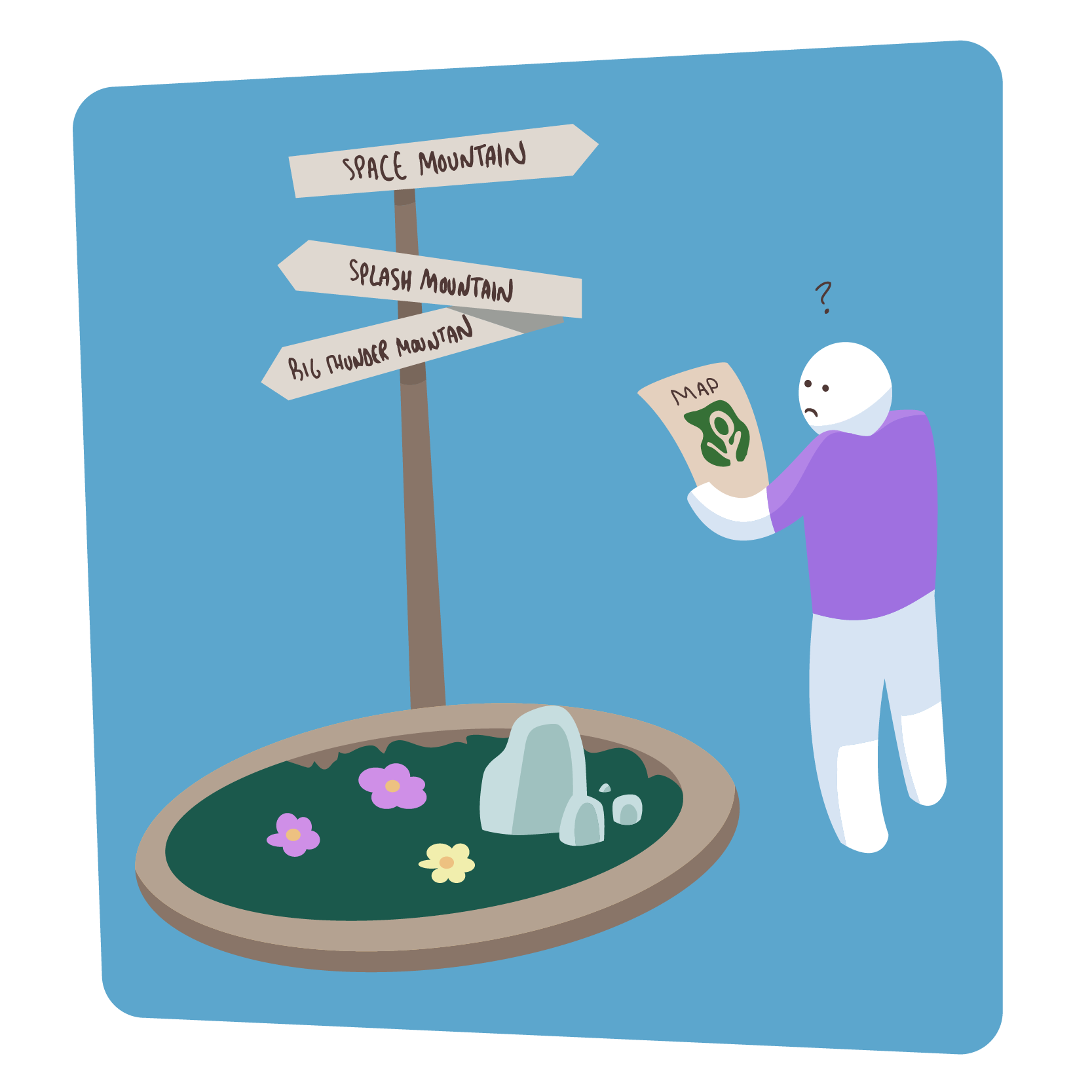 Not to be confused with a Teaching Map, a ‘Treasure Map’ is simply a listing of the products and services your Brand offers.
Not to be confused with a Teaching Map, a ‘Treasure Map’ is simply a listing of the products and services your Brand offers.
Here at The Visionary Planner, we like to think of anything that your Brand offers for Free as ‘Treats’. Anything you sell (a product or service) is a ‘Treasure’.
Why do we call it a ‘Treasure’? Because each product or service you sell should make your Guest feel like they just found a Treasure!
It should shower them with value. You want to create products and services that offer a unique Experience that exceeds Guest expectations. It should outshine other Brand's products in quality and craftsmanship.
Does Disneyland utilize ‘Treasure Maps’? They sure do! Stroll right up to their Ticket Booth and you’ll see a massive sign that tells you what types of ‘Treasures’ they sell, and how much they cost. Want a ticket for your kid? Want an adult ticket? How about a 2 day ticket? How about a ticket to Disneyland or their neighboring park California Adventure?
In fact, there are multiple Treasure Maps at Disneyland. Every restaurant, V.I.P. Experience and kiosk has a clearly defined Treasure Map. These Maps clearly communicate what their offers are, how much they cost and what the Guest gets with them.
For your Brand, you’ll want a list of what your products and services are so you, and your Guest's are clear.
Are you like In ’n Out Burger and only have a few menu items? Let your Guest know that. Are you like Cheesecake Factory and literally offer hundreds of menu items? Better write that list down so no one is confused.
In the case of Disneyland, they have so many ticket combinations it makes a lot of sense to proudly display their prices so Guests don’t eat up the time of the ticket sellers by asking the same question, ‘How much does that cost?’
Listing all of your Treasures can help you pinpoint any redundancies or low-volume sellers. Let’s assume you had two products that Teach potty training for puppies. Why confuse your Audience? Try combing them into one comprehensive product so you have less products to worry about Marketing. A Treasure Map should help you spot redundancies and arrive at an elegant, integrated suite of products.
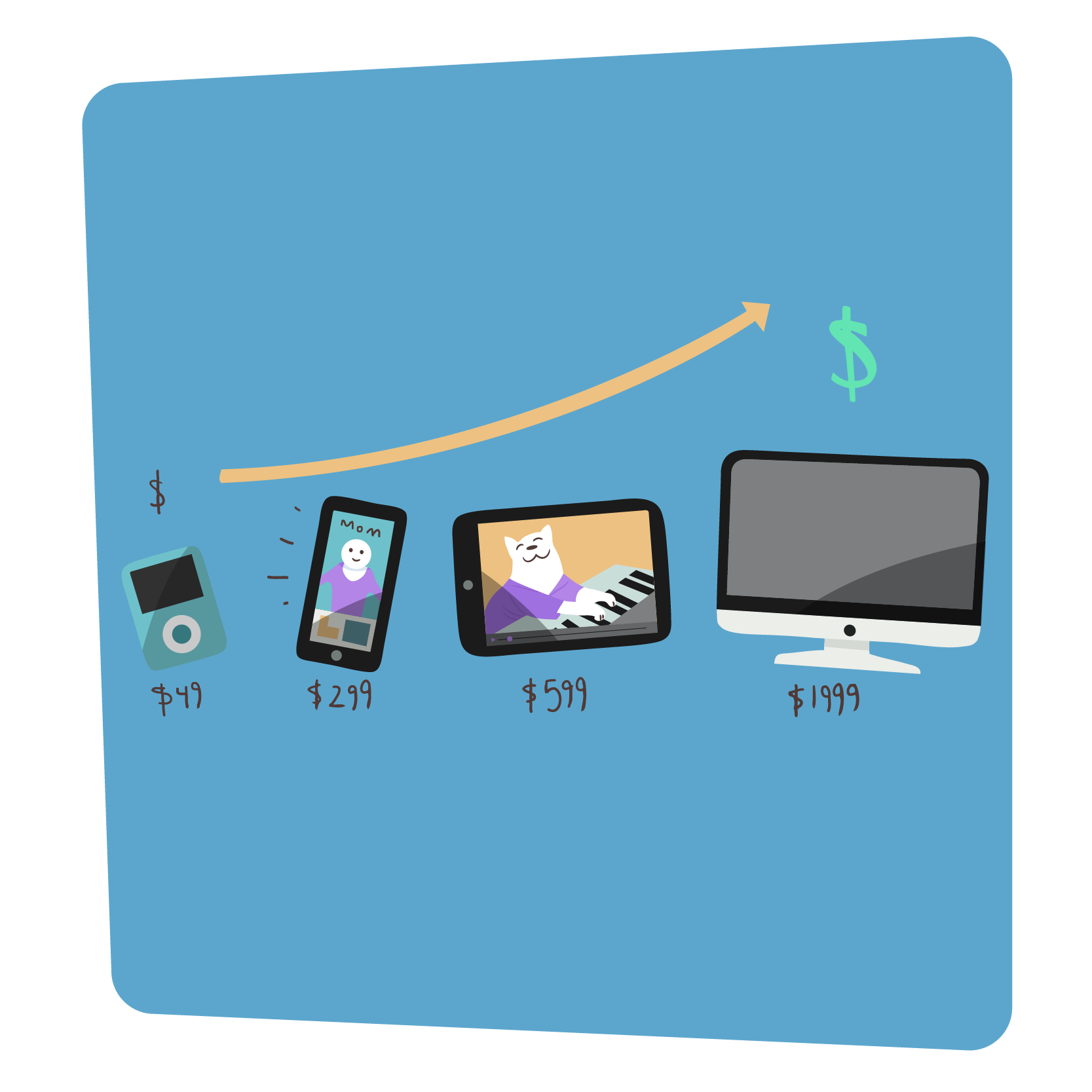
Another important reason to have a clearly defined Treasure Map is so you can make sure you have low-priced ‘get them in the door’ Treasures and higher priced Treasures. If you’re Apple, you'll want to have low priced iPods and iPhones that introduce an Audience to your Brand. Once they’re hooked you can ‘upsell’ them to your higher priced products like iPads, MacBooks and the iMac.
Plan your Treasures, make sure they scale in price, and make sure they’re all integrated to provide a seamless Experience (just like one ticket booth at Disneyland sells tickets to both Disneyland Resort Parks).
Just to be clear, a Treasure Map tells Guests what you are offering. A Teaching Map helps them to remember and understand why your Treasures are important to improving their lives.
8) Treasure #2
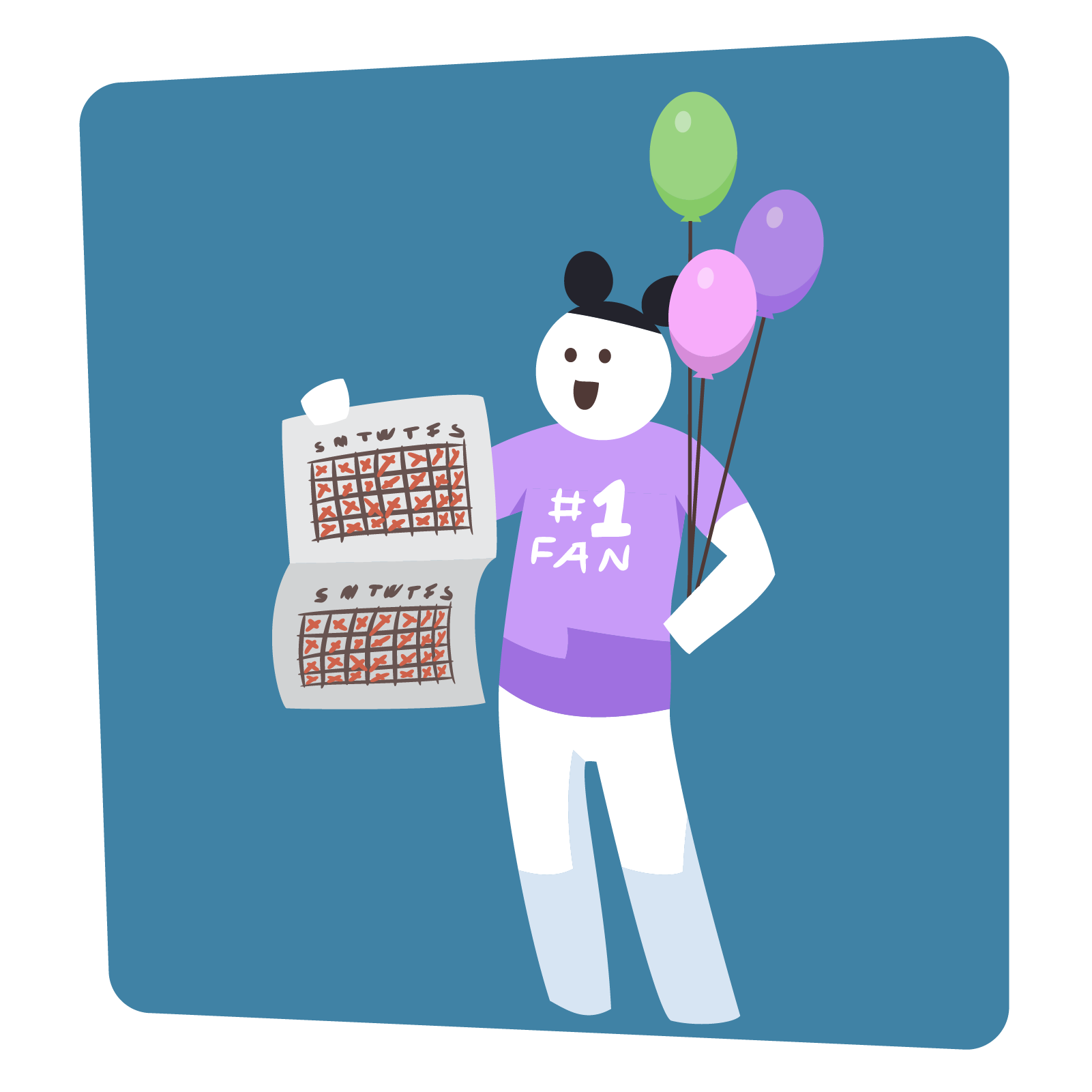 Disneyland has an annual pass that ranges from $20.00 to $80.00 a month.
Disneyland has an annual pass that ranges from $20.00 to $80.00 a month.
It's essentially a $500 to $1,000 product broken into payment cycles so the customer can find it affordable (and also justify buying something so pricy).
An online Brand also needs to have some sort of subscription service (also known as continuity).
Great examples of this in the entertainment or information space are companies like Netflix, Spotify or Lynda.
An example in the ‘discount club’ business model is Costco and Amazon Prime.
An example in the ‘Physical shipping’ model is the Dollar Shave Club. This is where customers get shipped a monthly box of physical goods.
An example the software service space would be Salesforce, Adobe Photoshop and Quickbooks.
Wrap Up
Congrats! You’re now at the end of Part 1.
You've learned that a Brand should create an amazing and unforgettable Experience that places the needs of your Audience first. You know see that knowing your Audience is the key to making a solid connection with them.
In order to create a world-class Brand you need to model your Audience’s Experience off of a Brand (and Experience) that is proven to dazzle others… a theme park like Disneyland!
You know you have to spend some time and energy to properly define what the Vision for your Brand is. Then you need to take the time to get the skills so you can be a true Authority in your niche.
We hope you learned more about the first Blocks you need to take in order to create an amazing Brand.
The next phase, Produce, is where you build all your Treasures, your WordPress Site, your Social Media Channels and your Audience Path or ‘touch points’. These are just fancy terms for you planning out the exact Experiences and interactions your Audience will have with your Brand as they decide whether to buy your Treasures. That involves several Blocks we’ll explain in Part 2 of this series of articles.
Read Part 2
Don’t regret not taking action today! Make your Vision happen now. We’re doing it, and so can you.
Ready for Part 2? Check it out now.
*All trademarks used are the properties of their respective trademark owners.
FREE Training To Build Your Blockbuster Brand
Join my FREE newsletter for weekly tips, tricks and templates to help you build a blockbuster brand:
We hate SPAM. We will never sell your information, for any reason.


